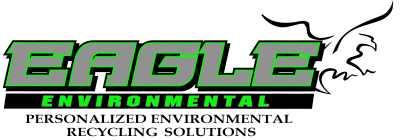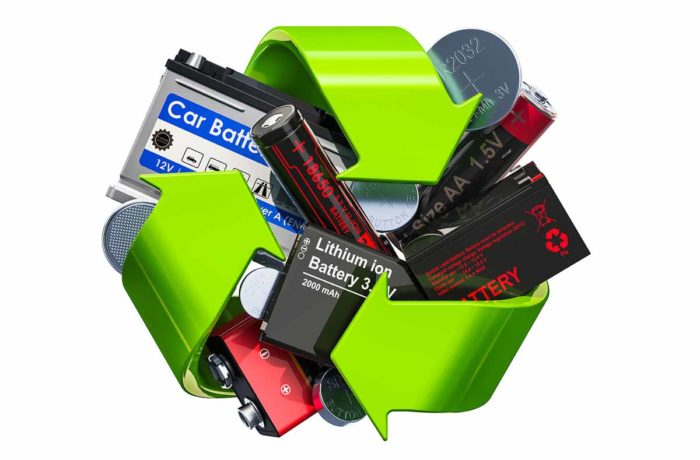To the layman, the term battery likely draws the image of an AA alkaline cell used to energize a TV remote control, flashlight, wireless mouse or any number of other household electronic devices. However, this variety of battery only scratches the surface when it comes to the industries and applications for which batteries are used on a daily basis.
There are specialized programs and personnel to help with whatever type of battery you’re looking to have recycled, the ever-present consumer battery, the hard-working and powerful industrial grade battery, and even the state-of-the-art large format batteries propelling the latest EV and hybrid vehicles down the road.
Consumer Batteries
We all depend on batteries for a variety of power sources in our daily lives. What would we do without our arsenal of cell phones, laptops, power tools, remote controls and other wireless devices? So many home office and entertainment devices, lighting and tools we depend on at home or school, are powered by consumer batteries. Today, even our children have become tremendous consumers of battery energy! Regardless of the size or type of battery you have at home, waste services can handle the disposal and recycling of all your consumer batteries, safely and efficiently.
Small, light, and crucial to daily living, consumer batteries are used in almost every aspect of daily living at home, school or office. Consumer batteries are generally used to power smaller portable electronics like laptops, cell phones, power tools, remote controls, video game systems, and all other devices that require energy without a cord.
The types of consumer batteries available are as diverse as their applications and uses. Alkaline, Nickel Cadmium, Nickel-Metal Hydride, Lead Acid, Lithium Ion and Primary Lithium, each battery type has unique properties, which require unique safety measures and recycling processes.
Nickel Cadmium (NiCad)
NiCad’s were one of the first rechargeable batteries to be widely adopted by consumers looking for solutions to power their portable devices. These batteries were at one time widely used in portable power tools, photography equipment, flashlights, emergency lighting, and hobby R/C.
However, the larger energy capacity of Nickel-Metal Hydride batteries as well as the potential environmental hazards involved with the improper disposal of the cadmium components have contributed to a decrease in the sale of these batteries.
Consumer NiCad batteries contain approximately 18% cadmium, a heavy toxic metal that requires that highest care during the battery recycling process. If you’re looking for an environmentally safe solution to managing your nickel cadmium batteries, Waste recycling businesses are uniquely permitted with proven processes to safely manage your end of life NiCad batteries.
Nickel-Metal Hydride
NiMH batteries are also rechargeable. While they have similar characteristics, NiMH has replaced NiCad batteries in many applications that require reusable and renewable power, because a NiMH battery can supply 2-3 times the energy capacity of a similarly sized NiCad. NiMH batteries are thought to be a safer energy option, as they do not contain cadmium, a toxic component found in NiCad batteries. Applications for NiMH batteries include power tools, laptops, cell phones, and even rechargeable alternatives to standard AA, AA, C, and D alkaline batteries.
Alkaline
Alkalines are a popular variety of non-rechargeable battery that are used throughout the home and office, and are commonly thought of as AA, AAA, C, D and 9V models. You’re familiar with these handy battery packages everywhere you shop and probably throw them in your shopping cart to make sure you have energy on hand to power all of your household toys and wireless devices. Alkalines are composed of Zinc and Manganese Dioxide, and derive their name from the alkaline electrolyte used to create the chemical reaction that generates energy. Over 10 billion individual alkaline batteries are manufactured every year on a worldwide basis; as a result, alkalines represent approximately 80% of the batteries manufactured in the U.S.
Primary Lithium
Often confused with rechargeable Lithium Ion batteries, Primary Lithium Batteries are entirely different in both their chemical composition and intended applications. Primary Lithium Batteries contain pure lithium metal, rather than lithium alloys, which has the positive effect of creating a very high energy density, and the negative effect of making the batteries far more reactive. In addition, unlike Li-Ion batteries, Primary Lithium batteries are not rechargeable and are only used in single-use applications. Such applications may include digital cameras, smoke detectors, alarm systems, automated defibrillators and other applications where high energy and a long shelf-life are a priority.
Primary Lithium Batteries can range in size from small button cells to battery packs that are similarly sized to car batteries. However, due to their very high energy capacity and highly reactive nature, all primary lithium batteries should be managed, stored, and treated with utmost care.
Lead Acid
Lead Acid batteries are the oldest form of rechargeable battery, having been invented by a French physicist in 1859. Despite being much heavier than today’s more advanced NiMH or Li-Ion batteries, lead batteries still account for approximately 40-45% of worldwide battery sales due to characteristics of long-life and high power. Applications for lead acid batteries tend to include ones where weight is not a major consideration, such as starter batteries for cars, or stationary backup power for desktop computers, data center servers and lighting systems.
Lead Acid batteries are composed of two highly hazardous components: lead and sulfuric acid. Both are 100% contained and treated at our recycling facilities, responsibly and safely.
Li-Ion
Li-Ion is one of the newest rechargeable batteries to be developed, but they have quickly become widely used throughout the portable power marketplace due to the high energy capacity in a relatively light weight package. The term Li-Ion does not refer to a single and unchanging battery composition, but instead, refers to numerous variations that simply share the characteristics of creating energy from the movement of ions from lithium alloys.
Lithium Cobalt Oxide (LiCoO2) batteries offer high energy density in a condensed package, making them perfect for portable consumer electronics like cell phones and laptops. Lithium Iron Phosphate (LiFePO4) batteries do not store as much energy as cobalt-based batteries, but are capable of releasing energy with greater force, which makes them ideal for high strength applications such as performance power tools. Other variations exist, each with their own unique energy characteristics, including Lithium Manganese Oxide (LMO), Lithium Nickel Manganese Cobalt Oxide (NMC), Lithium Nickel Cobalt Aluminum Oxide (NCA), and Lithium Titanate (LTO).
Li-Ion batteries can be dangerous under some conditions due to their high energy capacity and potential for reactivity. In addition, most Li-Ion batteries use a flammable electrolyte which creates a risk of fire should the batteries be abused. For that reason, proper management of these batteries is crucial.
Electric & Hybrid Vehicles
Hybrid & Electric Vehicle Batteries are used to power the latest generation of fuel efficient and gasoline-free cars. Ranging in size from 50 to 500 lbs., these batteries come in a diverse array of configurations, sizes, and chemistries.
Today’s economically and environmentally conscious consumers are embracing eco-friendly transportation options, and we are seeing more and more car and truck models and brands entering the market each year, all increasing the demand for enhanced closed loop recycling technologies and solutions.
Nickel-Metal Hydride
The rise in the popularity of hybrid vehicles can be traced to improvements made with NiMH battery technology. Previously, electric vehicles were powered with heavy and inefficient lead acid batteries, which weighed too much and did not hold enough energy to make the use of hybrids and EVs a workable form of transportation.
Advancements in the manufacturing of large format NiMH battery packs, offered car makers a lighter weight battery storage option with the ability to hold far more energy than previously possible. Mass-produced hybrid vehicles began to be widely adopted in the early 2000s with the arrival of the Toyota Prius and the Honda Insight, both of which used NiMH technology.
Since that time, many more makes and models of cars have used NiMH for battery storage. NiMH has proven itself to be a safe and reliable for use in automotive applications and shows signs of being utilized for the foreseeable future, despite the promise of increasingly advanced battery types such as Li-Ion.
Lithium Ion
Car makers and battery manufacturers have continued to work tirelessly to produce batteries that hold more energy, all the while be housed in packages that are smaller and lighter; this work lead to great advancements in the field of Li-Ion batteries, which recently began to replace NiMH as the batteries of choice for hybrid and EV applications.
Fully electric vehicles like the Chevy Volt, the Nissan Leaf, and every model of Tesla, all rely on Li-Ion batteries to achieve high mileage all electric driving modes, which would not be possible with less advanced technologies like lead acid or NiMH.
Recycling of these Li-Ion batteries becomes difficult, because unlike NiMH batteries that are all relatively the same, Li-Ion batteries can contain greatly different components from one manufacturer to another. That being said, many waste management businesses have the technology and expertise to recycle all commercially produced Li-Ion batteries, and can even work with manufacturers to develop methods of recycling prototype batteries yet to be mass produced.

